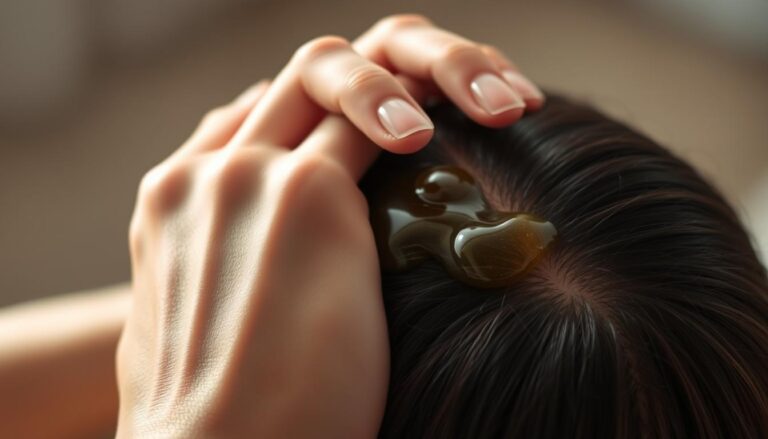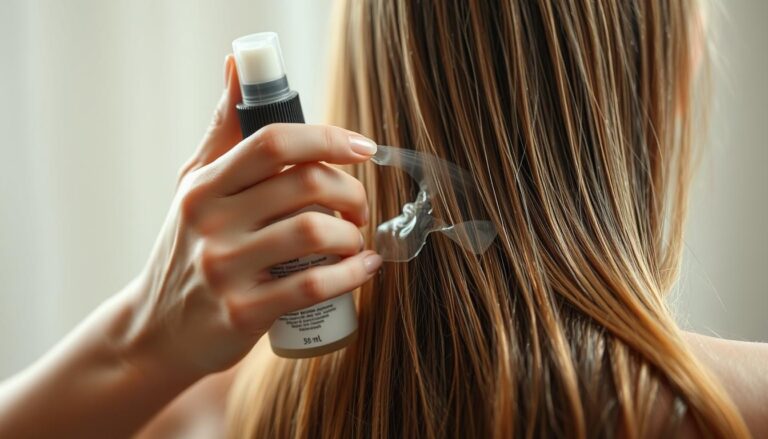At Glowskinhub.com, we believe beauty isn’t just a look—it’s a feeling

How to fix split ends without cutting hair
Damaged hair can be a significant concern for many, particularly when it results in split ends. These splits can travel up the hair shaft if left untreated, leading to further damage and potentially hindering hair repair. While cutting is a common solution, many seek alternatives to preserve their hair’s length and integrity.
Effective Hair Care practices play a crucial role in maintaining healthy locks and addressing split ends. By adopting the right methods, individuals can restore their hair’s health and appearance without resorting to cutting.
Key Takeaways
- Understanding the causes of split ends is crucial for effective hair repair.
- Simple Hair Care routines can significantly reduce damage.
- Nourishing treatments can help restore damaged hair.
- Regular maintenance is key to preventing further damage.
- Various hair repair methods are available for different hair types.
Understanding Split Ends: Causes and Types
Understanding the intricacies of split ends, including what causes them and their various forms, is essential for maintaining healthy hair. Split ends are not just a cosmetic issue; they can lead to further hair damage if not addressed properly.
What Causes Split Ends?
Split ends occur due to a variety of reasons, primarily related to hair damage. Excessive heat styling, chemical processing, and mechanical stress (such as frequent brushing or using hair ties) are common causes. Environmental factors like UV exposure and dry air can also contribute to the problem.
| Cause | Description | Prevention Tips |
|---|---|---|
| Excessive Heat Styling | Using heat styling tools frequently can damage hair. | Use heat protectants, limit styling tool usage. |
| Chemical Processing | Chemical treatments can weaken hair. | Use gentle chemicals, follow instructions. |
| Mechanical Stress | Frequent brushing or tight hairstyles. | Use gentle brushes, avoid tight hairstyles. |
Different Types of Split Ends
Split ends can manifest in different forms, including simple splits, feather splits, and tree splits. Each type indicates a different level or kind of damage. Recognizing the type of split end can help in choosing the appropriate treatment.
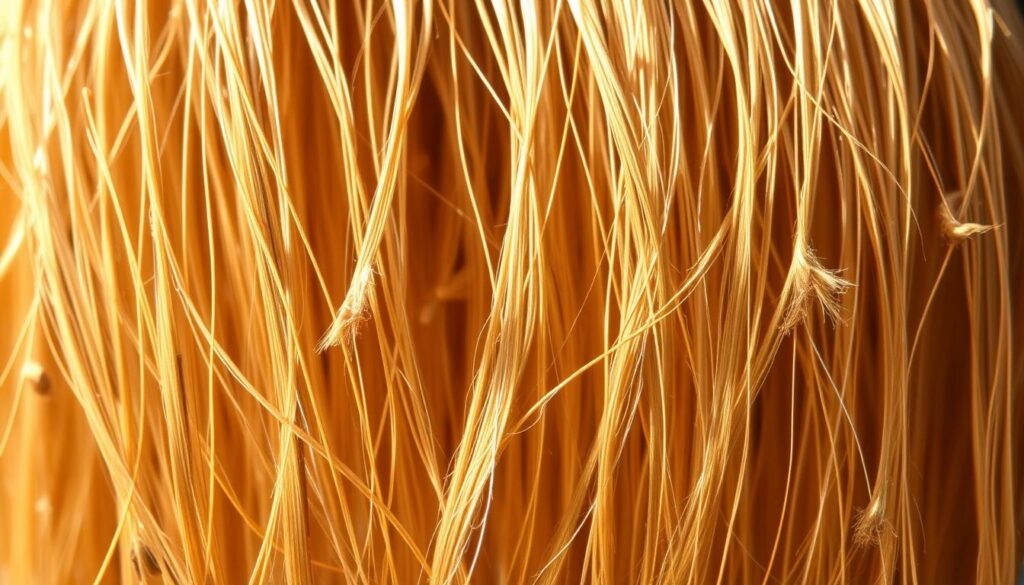
Why Prevention Is Better Than Treatment
Preventing split ends is more effective than trying to repair them. By understanding the causes and taking proactive measures, individuals can maintain healthier hair. Prevention includes using gentle Hair Care products, minimizing heat styling, and regularly conditioning hair.
By being aware of the causes and types of split ends, individuals can take the first step towards healthier, more resilient hair.
How to Identify If You Have Split Ends
The journey to healthier hair begins with recognising the signs of split ends. Split ends occur when the hair fibre splits into two or three strands, weakening the hair and leading to breakage if not addressed.
Visual Signs of Split Ends
Visually inspecting your hair is the first step in identifying split ends. Look for the following signs:
- Frayed or rough ends
- Split or forked ends
- A general dullness or lack of shine
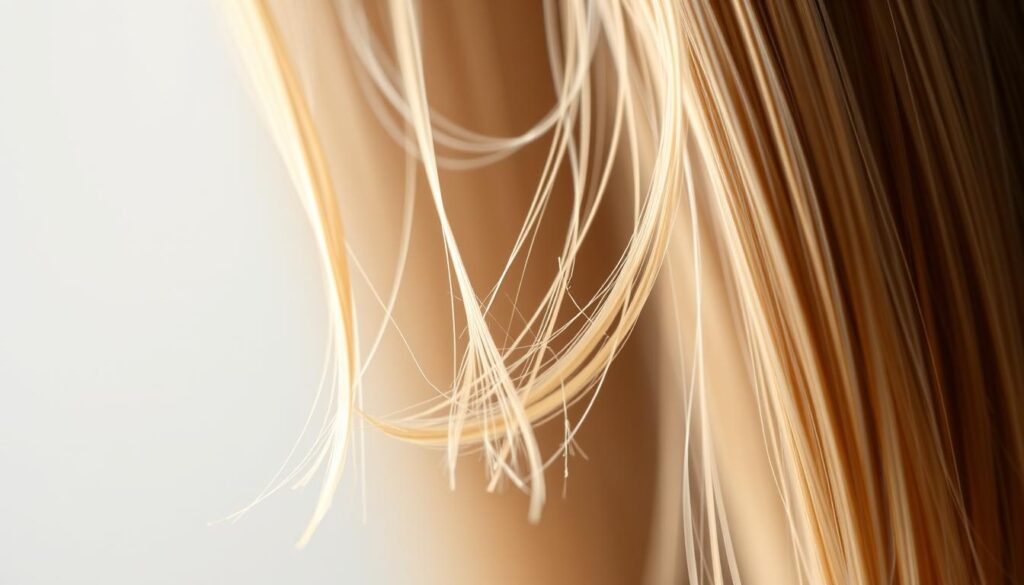
How Split Ends Feel When Touched
Besides visual inspection, you can also identify split ends by touch. Run your fingers through your hair, paying attention to any roughness or unevenness. Hair with split ends often feels:
- Rough to the touch
- Dry or brittle
- Tangled or knotty
Assessing the Severity of Your Split Ends
To assess the severity, examine the extent of the damage. Check if the split ends are limited to the tips or if they extend further up the hair shaft. You can also use a hair condition assessment technique by gently twisting a small section of hair; if it breaks easily, it may indicate severe split ends.
By identifying and assessing split ends, you can take the first steps towards repairing and preventing further damage, leading to healthier and more resilient hair.
Essential Hair Care Habits to Prevent Further Damage
Adopting the right Hair Care habits is crucial for preventing further damage to your hair. By incorporating a few simple practices into your daily routine, you can significantly improve the health and appearance of your locks.
Proper Washing Techniques
Washing your hair correctly is fundamental to its health. Use a gentle shampoo suitable for your hair type, and avoid using hot water, which can strip your hair of its natural oils. Instead, use warm water and finish with a cool rinse to help seal the cuticle.
Gentle Detangling Methods
Detangling is a critical step that requires care. Use a wide-tooth comb or a detangling brush, starting from the ends and working your way up. This approach minimizes breakage and reduces the risk of further damage.
Heat Protection Strategies
Heat styling tools can cause significant damage if not used properly. To protect your hair, it’s essential to employ effective heat protection strategies.
Reducing Blow Dryer Damage
When using a blow dryer, keep it on a lower heat setting and maintain a safe distance from your hair. Using a heat protectant spray can also help shield your hair from damage.
Safe Use of Straighteners and Curling Irons
For straighteners and curling irons, always use a heat protectant and avoid clamping or holding the tool in one place for too long. Regularly cleaning your styling tools can also prevent product buildup from damaging your hair.
By implementing these Hair Care habits and being mindful of preventing hair damage, you can enjoy healthier, more resilient hair. Regular attention to your hair’s needs, coupled with the right techniques, will make a significant difference in its overall health and appearance.
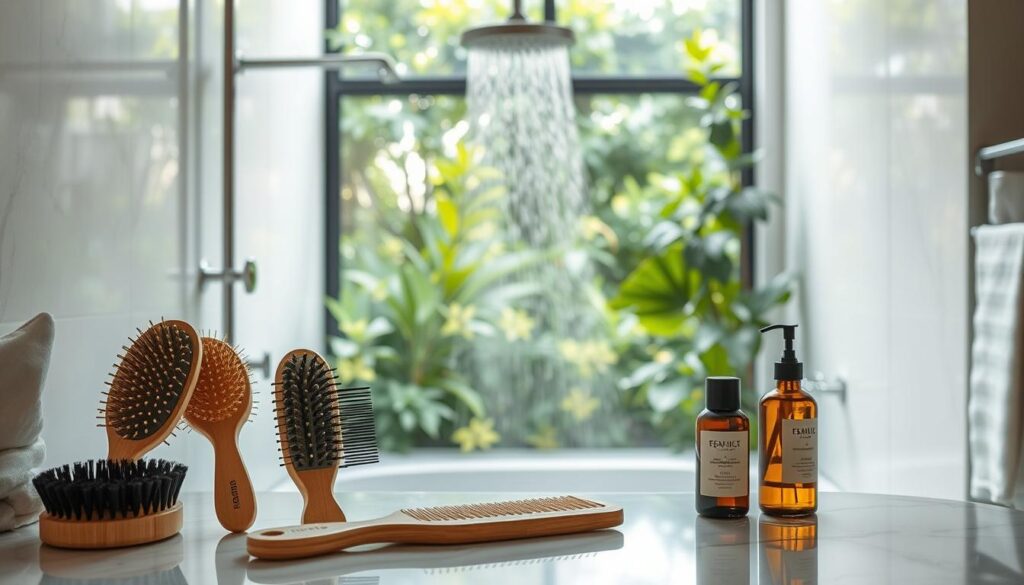
Nourishing Hair Masks for Split End Repair
To combat split ends, incorporating nourishing hair masks into your Hair Care routine is essential. Hair masks provide an intense dose of moisture and nourishment, helping to repair and protect damaged hair.
DIY Natural Hair Masks
Creating your own hair masks at home can be both cost-effective and beneficial for your hair. Here are a couple of recipes:
Avocado and Olive Oil Mask
Mash one ripe avocado and mix it with 2 tablespoons of olive oil. Apply the mask from roots to ends and leave it on for 30 minutes before rinsing with warm water. The healthy fats in avocado and olive oil deeply nourish and moisturize your hair.
Honey and Yoghurt Treatment
Mix 2 tablespoons of honey with 1 tablespoon of plain yoghurt. Apply this mask to your hair, focusing on the ends, and leave it on for 20-30 minutes. Honey’s natural humectant properties help retain moisture, while yoghurt’s lactic acid gently exfoliates the scalp.
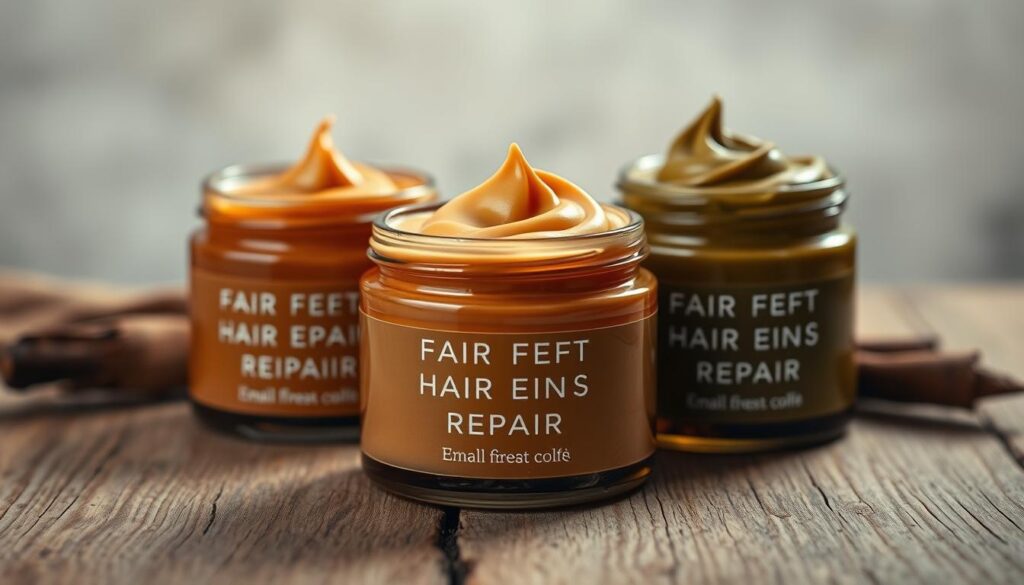
Store-Bought Treatment Masks
If DIY isn’t your preference, there are numerous store-bought hair masks designed to repair split ends. Look for products containing ingredients like keratin, argan oil, and shea butter, which are known for their nourishing properties.
| Product | Key Ingredients | Benefits |
|---|---|---|
| Keratin Repair Mask | Keratin, Coconut Oil | Repairs damage, strengthens hair |
| Argan Oil Mask | Argan Oil, Vitamin E | Moisturizes, protects from heat damage |
| Shea Butter Mask | Shea Butter, Honey | Nourishes, hydrates dry hair |
How Often to Apply Hair Masks
For optimal results, apply a hair mask once or twice a week, depending on your hair’s condition. If you have severely damaged hair, you may need to apply masks more frequently.
By incorporating nourishing hair masks into your routine, you can significantly improve the health and appearance of your hair, reducing the occurrence of split ends.
How to Fix Split Ends Without Cutting Hair: Professional Treatments
Professional salon treatments have become a go-to solution for individuals looking to fix split ends without losing hair length. These treatments offer a range of benefits, from repairing damaged hair to restoring its natural shine and health. By exploring the various professional options available, individuals can make informed decisions about the best course of treatment for their hair.
Salon Treatments for Split End Repair
Salon treatments for split end repair include a variety of procedures designed to mend and rejuvenate damaged hair. One popular treatment is the use of deep conditioning masks that are applied to the hair to provide intense nourishment. Additionally, some salons offer treatments that involve the application of hair bonding agents to repair the hair’s structure.
Keratin Treatments and Bond Builders
Keratin treatments are particularly effective for repairing split ends. These treatments involve applying keratin-based products to the hair, which are then sealed in using heat. This process helps to repair the hair’s cuticle, reducing frizz and enhancing shine. Bond builders, on the other hand, work by rebuilding the hair’s internal bonds, thereby strengthening the hair and reducing breakage.
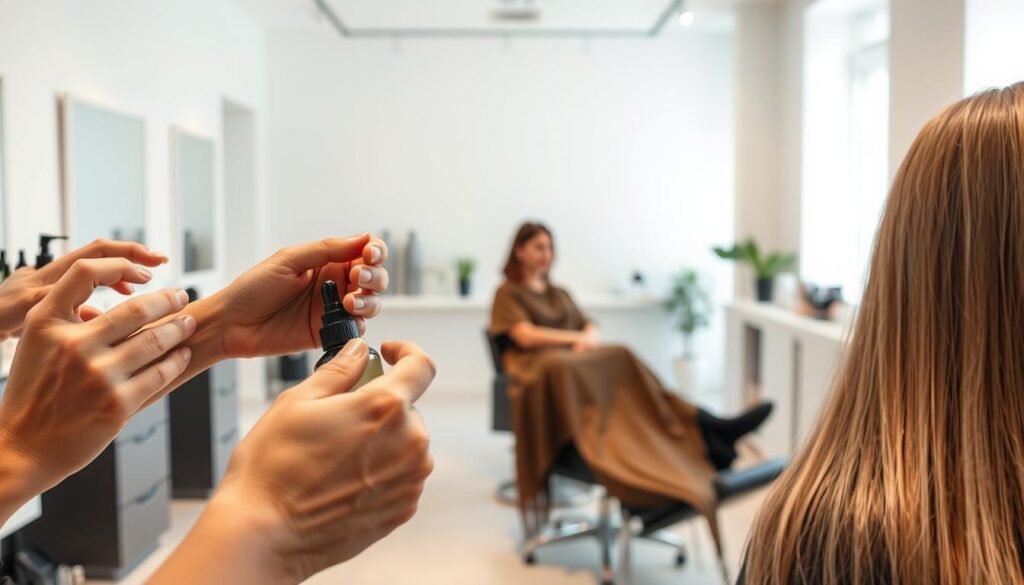
Cost Comparison of Professional Options
The cost of professional treatments for split end repair can vary significantly depending on the type of treatment, the length and thickness of the hair, and the salon’s location. Generally, keratin treatments can range from £50 to £150 or more, while bond builder treatments may start at around £30. It’s essential to consult with a salon professional to determine the most suitable treatment and to get an accurate quote.
| Treatment Type | Average Cost | Duration |
|---|---|---|
| Keratin Treatment | £50-£150 | 2-3 hours |
| Bond Builder Treatment | £30-£100 | 1-2 hours |
| Deep Conditioning Mask | £20-£50 | 30 minutes to 1 hour |
By considering these professional treatments, individuals can find an effective solution to fix split ends without cutting their hair. It’s crucial to choose a treatment that suits your hair type and needs.
Essential Hair Products for Split End Management
The right hair products can make a significant difference in managing split ends and maintaining healthy hair. When it comes to combating split ends, certain products can provide substantial benefits by nourishing, protecting, and strengthening your hair.
Leave-in Conditioners and Serums
Leave-in conditioners and serums are excellent for managing split ends. They help to moisturize and protect the hair, reducing the appearance of splits. Look for products containing ingredients like argan oil, coconut oil, or shea butter, which are known for their nourishing properties.
- Argan oil-based serums: These serums can deeply nourish your hair, reducing frizz and adding shine.
- Coconut oil leave-in conditioners: These help in detangling and moisturizing the hair, making it easier to manage split ends.
Split End Binding Products
Split end binding products are designed to temporarily repair split ends by binding the strands together. These products can be particularly useful for special occasions or when you’re waiting for a more permanent solution.
Some popular split end binding products include:
- Serums with silicones: These can help smooth the hair cuticle, temporarily binding split ends.
- Split end menders: These are intensive treatments that can help repair and bind split ends.
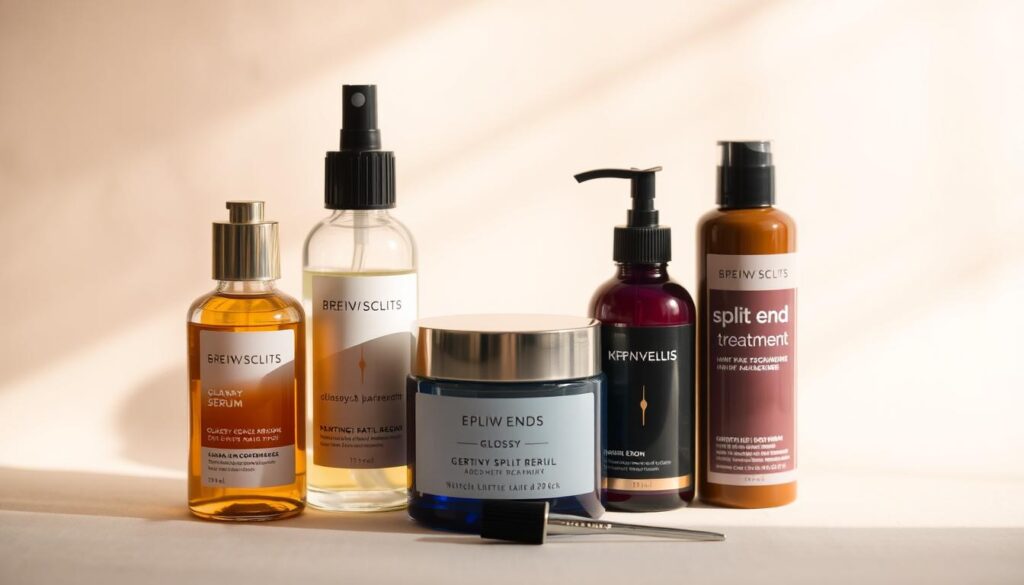
Heat Protectants Worth Investing In
Using heat styling tools can exacerbate split ends. Therefore, it’s crucial to use heat protectants when styling your hair with heat.
Some effective heat protectants include:
- Sprays with antioxidants: These not only protect your hair from heat damage but also help in maintaining its overall health.
- Cream-based protectants: These provide an extra layer of protection and can help in smoothing the hair.
By incorporating these hair products into your Hair Care routine, you can effectively manage split ends and maintain healthier, stronger hair.
Natural Remedies and Home Treatments
Embracing natural Hair Care methods can significantly help in managing and fixing split ends. Natural remedies offer a chemical-free alternative to salon treatments, allowing individuals to take control of their Hair Care at home.
Essential Oil Treatments
Essential oils such as lavender, tea tree, and argan oil can be beneficial for Hair Care. These oils are known for their nourishing properties and can help repair split ends. To use essential oils, mix a few drops with a carrier oil like coconut or olive oil and apply it to the ends of your hair.
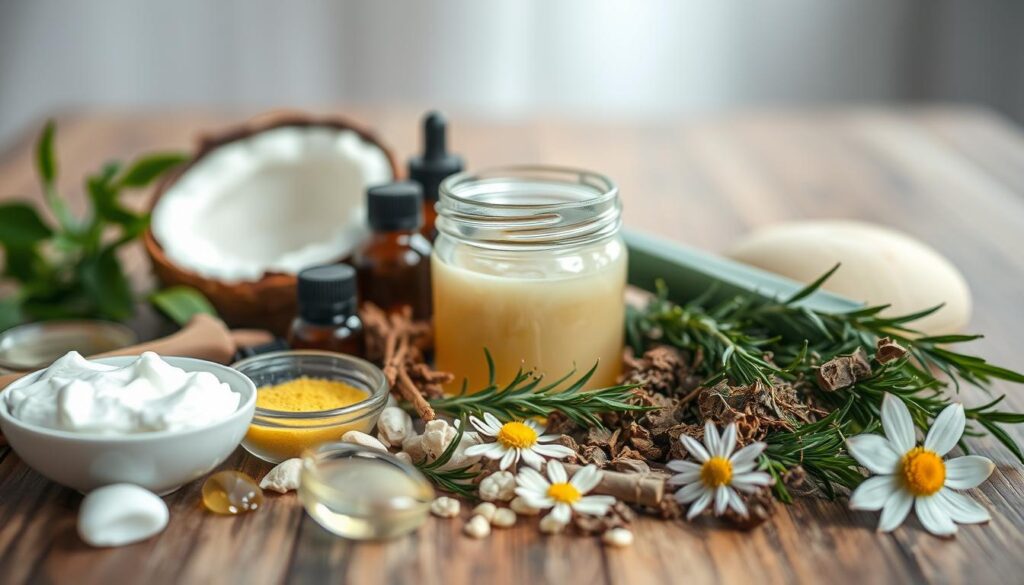
Apple Cider Vinegar Rinses
Apple cider vinegar is a popular home remedy for various hair issues, including split ends. It helps balance the pH of the scalp and adds shine to the hair. To use apple cider vinegar, mix it with water (1 part vinegar to 2 parts water) and use it as a final rinse after shampooing.
Coconut Oil and Other Natural Oils
Coconut oil is renowned for its hair benefits, including its ability to moisturize and repair damaged hair. Other natural oils like olive oil and avocado oil also provide nourishment and help in managing split ends. Apply a generous amount of oil to the hair ends, leave it on for at least an hour, and then shampoo as usual.
By incorporating these natural remedies into your Hair Care routine, you can effectively manage and fix split ends without cutting your hair. Regular use of these treatments can lead to healthier, stronger hair.
Proper Hair Brushing and Styling Techniques
Brushing and styling your hair correctly can make a significant difference in its overall health and appearance. Not only can proper techniques prevent damage, but they can also enhance your hair’s natural shine and manageability.
Choosing the Right Brushes and Combs
The first step in proper hair brushing is selecting the right tools. Wide-tooth combs are ideal for detangling wet hair, as they cause less breakage compared to regular combs or brushes. For brushing, boar bristle brushes are highly recommended as they distribute the hair’s natural oils, promoting healthy hair.
Damage-Free Styling Methods
When it comes to styling, minimizing heat damage is crucial. Using heat protectant sprays can significantly reduce the risk of damage when using heat styling tools. Moreover, opting for lower heat settings and limiting the frequency of heat styling can help maintain your hair’s integrity.
As celebrity hairstylist,
“Using the right tools and techniques while styling can make a huge difference. It’s not just about looking good, it’s about keeping your hair healthy.”
– Guy Tang.
Nighttime Hair Protection
Protecting your hair at night is an often-overlooked aspect of Hair Care. Using a silk or satin pillowcase can reduce friction and prevent breakage. Alternatively, wrapping your hair in a silk scarf or using a hair wrap can also help preserve your hairstyle and protect your hair while you sleep.
When Minimal Trimming Might Be Necessary
Not all split ends can be fixed without cutting; sometimes, a minimal trim is the best solution. While treatments and Hair Care routines can significantly improve the health of your hair, there are instances where a small trim can prevent further damage and breakage.
Signs That Treatments Aren’t Enough
If you’ve been diligently applying hair masks, using nourishing products, and still notice that your split ends persist or worsen, it might be a sign that minimal trimming is required. Persistent split ends can lead to further hair damage, including breakage, which can be frustrating and difficult to repair.
Another indicator is if your hair continues to feel brittle or looks unhealthy despite your best efforts. In such cases, a professional assessment can help determine if a slight trim is necessary.
Dusting Technique: Minimal Cutting for Maximum Health
The dusting technique is a method that involves cutting off only the damaged ends, thereby preserving the length of your hair. This technique is particularly beneficial for those who are trying to grow out their hair but still need to address split ends.
By carefully examining your hair and identifying the split ends, you can remove the damaged parts without sacrificing too much length. This method requires precision and patience, often making it a task best performed by professionals.
How to Trim Split Ends at Home
If you decide to trim your split ends at home, it’s essential to do so carefully to avoid causing more damage. Start by washing and drying your hair completely, then use a comb to carefully detangle it. Using sharp hair scissors, carefully snip off the split ends, taking care not to cut too much hair at once.
For those who are unsure, consulting a professional hairstylist who can apply the dusting technique or provide a simple trim can be a worthwhile investment. Regular trims, even if minimal, can keep your hair healthy and prevent the need for more significant cuts in the future.
Conclusion
Fixing split ends without cutting hair is achievable with the right Hair Care routine and treatments. By understanding the causes and types of split ends, you can take proactive steps to prevent further damage.
A combination of essential Hair Care habits, nourishing hair masks, and professional treatments can help repair and manage split ends. Using the right hair products, such as leave-in conditioners and heat protectants, is also crucial.
By incorporating natural remedies and home treatments, like essential oil treatments and coconut oil, into your Hair Care routine, you can promote healthy hair growth. Proper hair brushing and styling techniques, along with minimal trimming when necessary, will also contribute to maintaining healthy locks.
In summary, a comprehensive Hair Care approach is key to fixing split ends without cutting hair. By following the advice outlined in this article, you can achieve a split ends conclusion that leaves your hair looking healthy and vibrant, which is the ultimate goal of any Hair Care summary.

